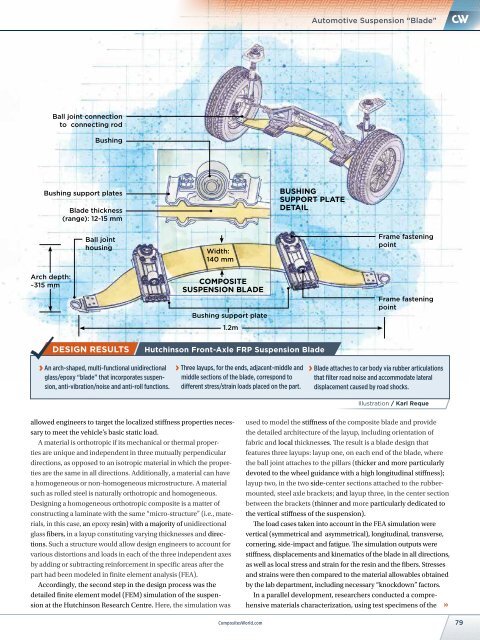FOR AUTO RTM
1VeKpGy
1VeKpGy
You also want an ePaper? Increase the reach of your titles
YUMPU automatically turns print PDFs into web optimized ePapers that Google loves.
Automotive Suspension “Blade”<br />
Ball joint connection<br />
to connecting rod<br />
Bushing<br />
Bushing support plates<br />
Blade thickness<br />
(range): 12-15 mm<br />
BUSHING<br />
SUPPORT PLATE<br />
DETAIL<br />
Ball joint<br />
housing<br />
Width:<br />
140 mm<br />
Frame fastening<br />
point<br />
Arch depth:<br />
~315 mm<br />
COMPOSITE<br />
SUSPENSION BLADE<br />
Bushing support plate<br />
1.2m<br />
Frame fastening<br />
point<br />
Hutchinson Front-Axle FRP Suspension Blade<br />
› An arch-shaped, multi-functional unidirectional<br />
glass/epoxy “blade” that incorporates suspension,<br />
anti-vibration/noise and anti-roll functions.<br />
› Three layups, for the ends, adjacent-middle and<br />
middle sections of the blade, correspond to<br />
different stress/strain loads placed on the part.<br />
› Blade attaches to car body via rubber articulations<br />
that filter road noise and accommodate lateral<br />
displacement caused by road shocks.<br />
Illustration / Karl Reque<br />
allowed engineers to target the localized stiffness properties necessary<br />
to meet the vehicle’s basic static load.<br />
A material is orthotropic if its mechanical or thermal properties<br />
are unique and independent in three mutually perpendicular<br />
directions, as opposed to an isotropic material in which the properties<br />
are the same in all directions. Additionally, a material can have<br />
a homogeneous or non-homogeneous microstructure. A material<br />
such as rolled steel is naturally orthotropic and homogeneous.<br />
Designing a homogeneous orthotropic composite is a matter of<br />
constructing a laminate with the same “micro-structure” (i.e., materials,<br />
in this case, an epoxy resin) with a majority of unidirectional<br />
glass fibers, in a layup constituting varying thicknesses and directions.<br />
Such a structure would allow design engineers to account for<br />
various distortions and loads in each of the three independent axes<br />
by adding or subtracting reinforcement in specific areas after the<br />
part had been modeled in finite element analysis (FEA).<br />
Accordingly, the second step in the design process was the<br />
detailed finite element model (FEM) simulation of the suspension<br />
at the Hutchinson Research Centre. Here, the simulation was<br />
used to model the stiffness of the composite blade and provide<br />
the detailed architecture of the layup, including orientation of<br />
fabric and local thicknesses. The result is a blade design that<br />
features three layups: layup one, on each end of the blade, where<br />
the ball joint attaches to the pillars (thicker and more particularly<br />
devoted to the wheel guidance with a high longitudinal stiffness);<br />
layup two, in the two side-center sections attached to the rubbermounted,<br />
steel axle brackets; and layup three, in the center section<br />
between the brackets (thinner and more particularly dedicated to<br />
the vertical stiffness of the suspension).<br />
The load cases taken into account in the FEA simulation were<br />
vertical (symmetrical and asymmetrical), longitudinal, transverse,<br />
cornering, side-impact and fatigue. The simulation outputs were<br />
stiffness, displacements and kinematics of the blade in all directions,<br />
as well as local stress and strain for the resin and the fibers. Stresses<br />
and strains were then compared to the material allowables obtained<br />
by the lab department, including necessary “knockdown” factors.<br />
In a parallel development, researchers conducted a comprehensive<br />
materials characterization, using test specimens of the<br />
CompositesWorld.com 79


